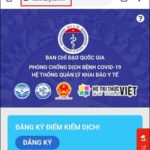With the ongoing COVID-19 pandemic, many people opt for self-testing at home due to its convenience and speed. However, rapid antigen tests can sometimes yield false positive results, causing uncertainty and confusion among those who test themselves.
Read on as we outline a doctor’s guide to interpreting your rapid antigen test results and understanding potential false positives.
1 Interpreting Your Rapid Antigen Test Results
When reading your rapid antigen test results, look for the appearance of two lines, one at the control line (C) and another at the test line (T). If both lines appear, the result is positive. If only the control line (C) appears, the result is negative.
 A positive result with both the control and test lines visible
A positive result with both the control and test lines visible
However, it’s important to note that sometimes the test line (T) may appear faint or less prominent than the control line (C). This can cause uncertainty, especially when the instructions do not explicitly mention faint lines.
According to Dr. Hudson-Peacock, an emergency medicine specialist working in London hospitals, if the second line is faint, it’s crucial to pay attention to the timing of the result.
Reference:
 Pay attention to the timing if the second line is faint
Pay attention to the timing if the second line is faint
If both the control line (C) and the test line (T) appear within the specified time frame given in the test kit instructions (usually within 30 minutes of performing the test), the result is considered truly positive. In this case, self-isolate and register for a PCR test with your local health authorities to confirm the result.
On the other hand, if the second line (test line – T) appears after the specified time frame (beyond 30 minutes), it is likely a false positive result. You may repeat the rapid antigen test to confirm.
Reference:
2 Understanding False Positives in Rapid Antigen Tests
Dr. Hudson-Peacock explains that false positive results on rapid antigen tests can be attributed to various factors, including diet, low viral load, and other potential interferences.
Note: Different test kits may have varying time frames for interpreting results. Always read the instructions carefully to ensure you are interpreting the results correctly.
 Read the test kit instructions carefully to interpret results accurately
Read the test kit instructions carefully to interpret results accurately
He emphasizes that PCR tests are more accurate and should be considered if there is any doubt about the rapid antigen test result. PCR tests are processed in laboratories and are considered the gold standard for COVID-19 detection.
Note: Always purchase rapid antigen test kits from reputable pharmacies to ensure their authenticity and accuracy. Avoid buying from unknown sources to prevent the risk of using counterfeit or inaccurate tests.
Reference:
3 4 Things to Keep in Mind to Minimize False Positives
 Minimizing the risk of false positives
Minimizing the risk of false positives
To reduce the likelihood of a false positive result, it’s important to follow these steps before performing a rapid antigen test:
- Wash your hands thoroughly.
- Blow your nose to minimize excess mucus.
- Avoid eating or drinking shortly before performing the test.
- Carefully follow the instructions provided with the test kit.
Source: Thanh Nien News
Further Reading:
We hope this guide has provided you with valuable insights on interpreting your rapid antigen test results and understanding false positives. For more information, feel free to explore additional resources. Stay safe and informed during these challenging times.





































